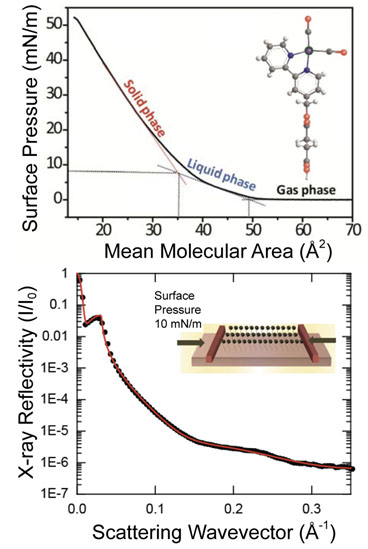
General Overview: Researchers at the Wisconsin MRSEC are working to make energy-related devices, such as light emitting diodes (LEDs) and solar cells, more efficient, more stable, and easier to fabricate. The research focuses on the critical challenge of developing new methods to create ultrathin, highly organized layers of molecules, termed donors, that efficiently transfer charges between the compounds that comprise these devices. The Wisconsin MRSEC has synthesized organic molecules (see the structure in the top figure) that can be pre-organized as a one molecule-thick layer on the surface of water, and then transferred onto the interfaces of devices. This approach has yielded remarkably well ordered, densely packed, and stable monolayers of donor molecules that have provided new insights into how charge moves across interfaces. The graphs in the figure demonstrate the precision with which the molecules can be manipulated on the surface of water, as measured by the pressure that the molecules generate (top) and their degree of organization (bottom) when they are tightly packed within the molecule-thick film. The exactness with which these novel, ultrathin, materials can now be fabricated is enabling the design of devices with improved performance that use a wider range of molecular materials than was possible in the past.
Technical Description: The development of a detailed understanding of the fundamental processes that regulate charge transfer at organic-inorganic interfaces requires an unprecedented level of control over the structure and dynamical properties of these interfaces. Since conventional deposition (e.g. crystal growth) techniques cannot be used to synthesize these materials, controlling the packing and time-dependent orientations of donor molecules at these interfaces has been an unresolved challenge. IRG2 of the Wisconsin MRSEC has addressed this challenge by leveraging directed assembly methods based on Langmuir-Blodgett (LB) techniques to create well-ordered, densely packed monolayers of large donor molecules (see structure in top figure) on SiO2 and TiO2. Results obtained by IRG2 show that rhenium-bipyridine dye molecules form a closely packed monolayer at a well-defined surface pressure of approximately 10 mN/m (see top figure). Detailed characterization using atomic force microscopy and x-ray reflectivity (see bottom figure) confirm that the dye molecules are extended to their maximum lengths and oriented with the long axis of the molecule normal to the interface. The monolayers were transferred to solid substrates with high transfer ratio, thus opening up a path to study the effect of specific molecular orientations or aggregation states on the charge injection dynamics in organic/inorganic devices. The degree of molecular orientation, uniformity, and thickness of these films, when combined with unique ultrafast spectroscopic characterization tools in the Wisconsin MRSEC, are enabling studies that have the potential to greatly improve the performance, reliability, and cost of a broad range of devices that involve charge transfer at interfaces.